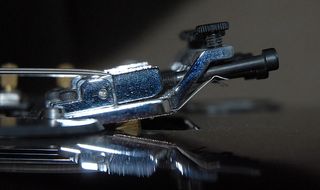How to Balance Your Guitar’s Vibrato
From a Standard Tremolo to a locking Floyd Rose: learn how to set up your guitar's whammy bar

We interrupt our regular top nut series to bring you a request. I’ve had a lot of you asking for a guide to balancing your guitar’s vibrato unit. Well, here it is.
The good news is that the whole balancing process is the same for most locking and non-locking vibrato units; i.e. any unit that’s based on the classic Stratocaster spring vs. string tension design.
The first step is to decide how you want your vibrato to sit. Here are the main three options:
1. Strat vibrato, flat on the body: I would hazard a guess that most Strat players (or owners of those guitars that, ahem, pay tribute to Leo Fender’s original design) prefer their vibrato to lay firmly on the guitar’s body. In other words, it can only be pushed forward to loosen the strings; not pulled back. Option 1 also applies to those locking vibrato-equipped guitars (like my Fender Standard Stratocaster HSS) that don’t have a recess to allow you to pull the vibrato unit up.
2. Strat vibrato, with some pull-up: This setup allows you to get some of that Jeff Beck-style warble. Some surf guitarists like to set their Strat vibratos with a bit of pull-up; wobbling the arm sounds great with your reverb whacked all the way up.
3. Locking vibrato, balanced. This is for locking vibrato loaded guitars that have a recess in the body (think the Ibanez JEM and its Lion’s Claw) to allow the arm to be pulled up, raising the pitch of the strings. The vibrato should be set so that it sits parallel to the guitar’s body, not on it.
BALANCING THE VIBRATO
Before you begin the process of balancing your vibrato (or any setup task for that matter), you have to make sure that the guitar’s strings are properly stretched. Tune the strings, give 'em a good ol' stretch, then re-tune. It can take a while for the tuning to settle, so keep on stretching and re-tuning until you don’t need to anymore.
Take a look at the angle of the vibrato from the side (See photo 1 in the gallery below). Is it sitting at your preferred angle? If not, remove the plastic plate on the back of the guitar. With the backplate removed (and the screws stored somewhere safe), you’ll see two large screws holding a steel "claw" and some vibrato springs (See photo 2).
You can alter the vibrato's angle by adjusting the two large screws with the correct-sized screwdriver. Why do I always say "correct-sized" when it comes to tools? Well, the bolts and screws fitted to some guitars can be quite soft. The wrong-sized screwdriver can damage the heads on these vulnerable parts.
If the vibrato angles toward the body, turn the screws anti-clockwise to release tension on the vibrato springs; and clockwise if it's angled away from the body to increase tension on the springs. Each time you turn the screws a half turn, retune the guitar and check the new angle of the vibrato. Repeat the process until you get the angle you want. It really is that easy.
The eventual result is that the tension between the screws and the strings will be balanced and the vibrato unit will stay exactly where you want it to. If you have a locking top nut, you can now bolt it down (See photo 3).
There’s a part two to this guide which, will be with you shortly. Until then, please try to stay balanced.
And since we're on the topic, here's part 2!



Get The Pick Newsletter
All the latest guitar news, interviews, lessons, reviews, deals and more, direct to your inbox!
Ed Mitchell was Reviews Editor on Total Guitar magazine from 2003, and his guitar-modding column, Ed’s Shed, appeared in print on both sides of the Atlantic (in both Total Guitar and Guitar World magazines). He was the Editor of The Blues Magazine from 2012-16, and a contributor to Guitarist, Classic Rock and Louder. He died in October 2022, aged 52. Between them, the websites Guitar World, Louder and MusicRadar host over 400 of his articles – among them interviews with Billy Gibbons, Paul Weller, Brian Setzer, profiles on Roy Buchanan, Duane Allman and Peter Green, a joint interview with Jimmy Page and Jack White, and dozens of guitar reviews – and that’s just the ones that made it online.



![Joe Bonamassa [left] wears a deep blue suit and polka-dotted shirt and plays his green refin Strat; the late Irish blues legend Rory Gallagher [right] screams and inflicts some punishment on his heavily worn number one Stratocaster.](https://cdn.mos.cms.futurecdn.net/cw28h7UBcTVfTLs7p7eiLe-840-80.jpg)






